1988 PONTIAC FIERO light
[x] Cancel search: lightPage 882 of 1825
![PONTIAC FIERO 1988 Service Repair Manual
DRIVEABILITY AND EMISSIONS 5.OL (VIN F) & 5.7L (VIN 8) 6E3-C1-7
UPPER RADIATOR
/ MAF SENSOR ASM
1 CLAMP ASM 1.4-2.0 N-rn (1-1.4 LBS. FT.) 1 BOLTISCREW (2)
1 BRACI<ET MAF SENSOR I5] BOLTISCREW (2 PONTIAC FIERO 1988 Service Repair Manual
DRIVEABILITY AND EMISSIONS 5.OL (VIN F) & 5.7L (VIN 8) 6E3-C1-7
UPPER RADIATOR
/ MAF SENSOR ASM
1 CLAMP ASM 1.4-2.0 N-rn (1-1.4 LBS. FT.) 1 BOLTISCREW (2)
1 BRACI<ET MAF SENSOR I5] BOLTISCREW (2](/manual-img/50/57415/w960_57415-881.png)
DRIVEABILITY AND EMISSIONS 5.OL (VIN F) & 5.7L (VIN 8) 6E3-C1-7
UPPER RADIATOR
/ MAF SENSOR ASM
1 CLAMP ASM 1.4-2.0 N-rn (1-1.4 LBS. FT.) 1 BOLTISCREW (2)
1 BRACI
Install or Connect (Figure C1-9)
1. Mem-Cal in Mem-Cal socket.
Important
Press only on the ends of the Mem-Cal.
Small notches in the Mem-Cal must be aligned
with the small notches in the Mem-Cal socket.
Press on the ends of the Mem-Cal until the
retaining clips snap into the ends of the Mem-Cal.
Do not press on the middle of the Mem-Cal, only
on the ends.
2. Access cover on ECM.
3. ECM in passenger compartment.
4. Connectors to ECM.
5. Right hand hush panel.
6. Negative battery cable.
Functional Check
1. Turn ignition "ON".
2. Enter diagnostics.
A. Allow Code
12 to flash four times to verify no
other codes are present.
This indicates the Mem-Cal is installed
properly and the ECM is functioning.
B. If trouble Code 51 occurs, or if the "Service
Engine Soon" light is "ON" constantly with no
codes, the Mem-Cal is not fully seated or is
defective.
@ If not fully seated, press firmly on the ends
of the Mem-Cal.
If it is necessary to remove the Mem-Cal,
follow the previous removal instructions.
COOLANT SENSOR
NOTICE:
Care must be taken when handling
coolant sensor. Damage to coolant sensor
will affect proper operation of the fuel
injection system.
Remove or Disconnect
1. Negative battery cable.
2. Air inlet duct.
3. Electrical connector.
4. Carefully back out coolant sensor.
Install or Connect
1. Sensor in engine.
2. Electrical connector.
3. Air inlet tube.
4. Negative battery cable.
ENGINE HARNESS ASM
Figure Cl-1 l Relays
Page 900 of 1825
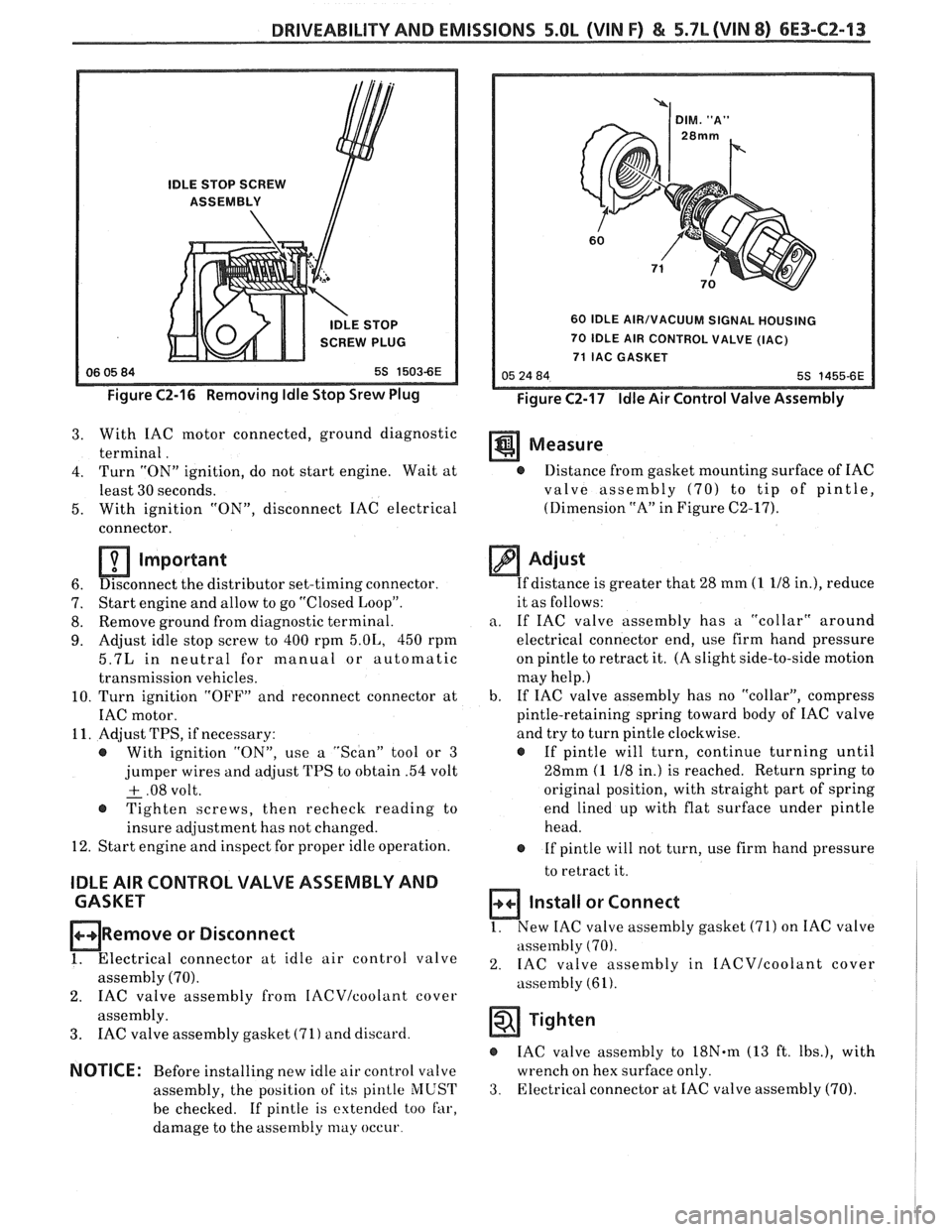
DRIVEABILITY AND EMISSIONS 5.OL (VIN F) & 5.7b (VIN 8) 6E3-CZ-13
IDLE STOP SCREW
ASSEMBLY
IDLE STOP
SCREW PLUG
Figure C2-16 Removing Idle Stop Srew Plug
60 IDLE AIR/VACUUM SIGNAL HOUSING
70 IDLE AIR CONTROL VALVE (IAC)
71 IAC GASKET
Figure C2-17 Idle Air Control Valve Assembly
3. With IAC motor connected, ground diagnostic
terminal. Measure
4. Turn "ON" ignition, do not start engine. Wait at @ Distance from gasket mounting surface of IAC
least 30 seconds. valve assembly
(70) to tip of pintle,
5. With ignition
"ON", disconnect IAC electrical (Dimension
"A" in Figure C2-17).
connector.
Important
6. Disconnect
the distributor set-timing connector.
7. Start
engine and allow to go "Closed Loop".
8. Remove
ground from diagnostic terminal.
9. Adjust idle stop screw to 400 rpm 5.01,, 450 rpm
5.7L in neutral for manual or automatic
transmission vehicles.
10. Turn ignition "OFF" and reconnect connector at
IAC motor.
11. Adjust TPS, if necessary:
@ With ignition "ON", use a "Scan" tool or 3
jumper wires and adjust TPS to obtain .54 volt
+ .08 volt. - @ Tighten screws, then recheck reading to
insure adjustment has not changed.
12. Start engine and inspect for proper idle operation.
IDLE AIR CONTROL VALVE ASSEMBLY AND
CASKET
ORemove or Disconnect
1. Electrical connector at idle air control valve
assembly (70).
2. IAC valve assembly from IACVIcoolant cover
assembly.
3. IAC valve assembly gasket (71) and discard.
NOTICE: Before installing new idle air control valve
assembly, the position of its
pinlle MUST
be checked. If pintle is extended too far,
damage to the assembly
may occur
Adjust
If distance is greater that 28 mm (1 118 in.), reduce
it as follows:
a. If IAC valve assembly has a "collar" around
electrical connector end, use firm hand pressure
on pintle to retract it. (A slight side-to-side motion
may help.)
b. If
IAC valve assembly has no "collar", compress
pintle-retaining spring toward body of IAC valve
and try to turn pintle clockwise.
@ If pintle will turn, continue turning until
28mm
(1 118 in.) is reached. Return spring to
original position, with straight part of spring
end lined up with flat surface under pintle
head.
@ If pintle will not turn, use firm hand pressure
to retract it.
Install or Connect
1. New IAC valve assembly gasket (71) on IAC valve
assembly
(70).
2. IAC valve assembly in IACVIcoolant cover
assembly (61).
Tighten
IAC valve assembly to 18N.m (13 ft. Ibs.), with
wrench on hex surface only.
3. Electrical connector at IAC valve assembly (70).
Page 905 of 1825
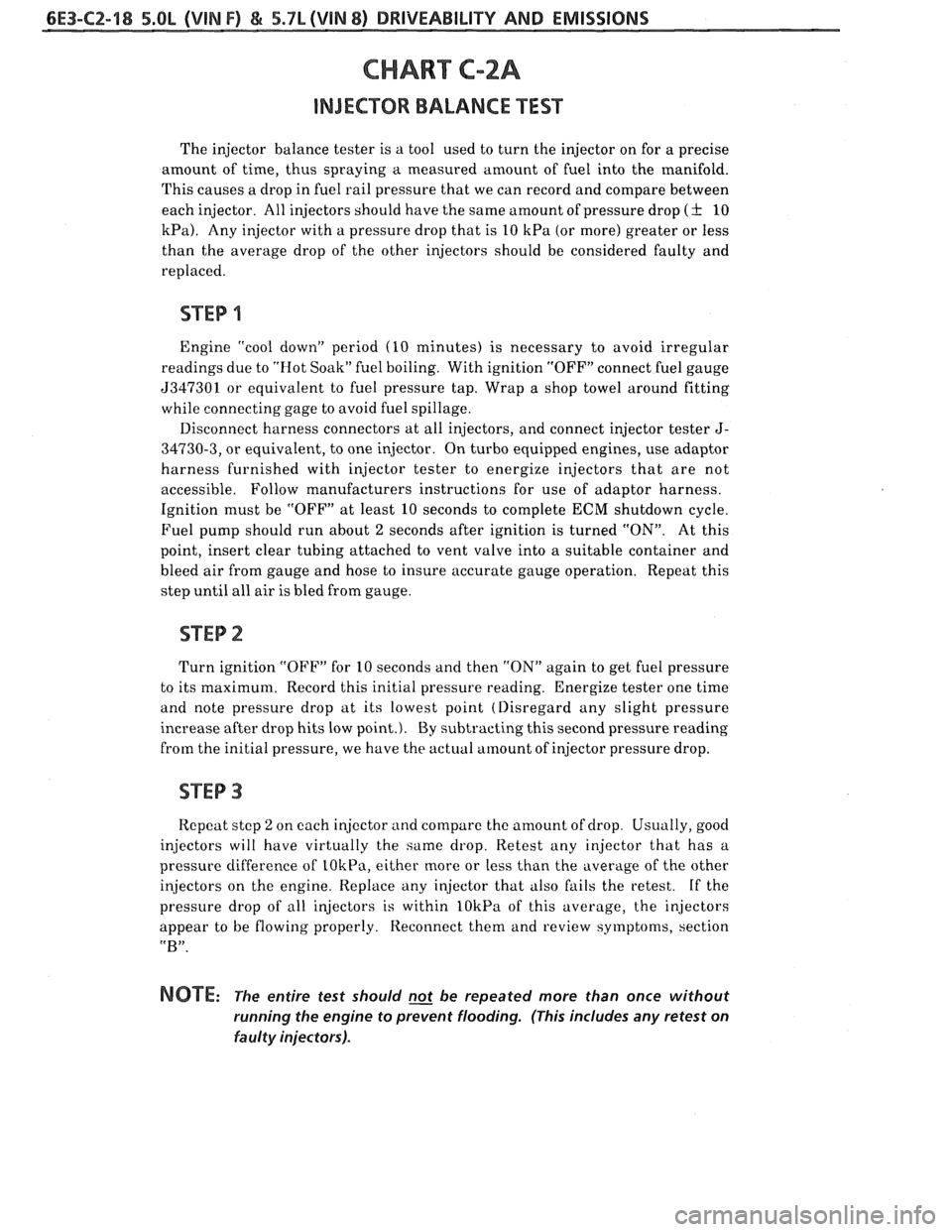
6E3-CZ-18 5.OL (VIN F) & 5.7L(VIN 8) DRIVEABILITY AND EMISSIONS
CHART C-2A
INJECWR BALANCE TEST
The injector balance tester is a tool used to turn the injector on for a precise
amount of time, thus spraying
a measured amount of fuel into the manifold.
This causes a drop in fuel rail pressure that we can record and compare between
each injector. All injectors should have the same amount of pressure drop
( f 10
kPa). Any injector with a pressure drop that is 10 kPa (or more) greater or less
than the average drop of the other injectors should be considered faulty and
replaced.
STEP 1
Engine "cool down" period (10 minutes) is necessary to avoid irregular
readings due to "Hot Soak" fuel boiling. With ignition "OFF" connect fuel gauge
5347301 or equivalent to fuel pressure tap. Wrap a shop towel around fitting
while connecting gage to avoid fuel spillage.
Disconnect harness connectors at all injectors, and connect injector tester
J-
34730-3, or equivalent, to one injector. On turbo equipped engines, use adaptor
harness furnished with injector tester to energize injectors that are not
accessible. Follow manufacturers instructions for use of adaptor harness.
Ignition must be "OFF" at least 10 seconds to complete
ECM shutdown cycle.
Fuel pump should run about
2 seconds after ignition is turned "ON". At this
point, insert clear tubing attached to vent valve into a suitable container and
bleed air from gauge and hose to insure accurate gauge operation. Repeat this
step until all air is bled from gauge.
Turn ignition
"OFF" for 10 seconds and then "ON" again to get fuel pressure
to its maximum. Record this initial pressure reading. Energize tester one time
and note pressure drop at its lowest point (Disregard any slight pressure
increase after drop hits low point.). By subtracting this second pressure reading
from the initial pressure, we have
the actual amount of injector pressure drop.
STEP 3
Rcpcat stcp 2 on each injector and compare the amount of drop. Usually, good
injectors will have virtually the same drop. Retest any injector that has a
pressure difference of
LOkPa, either more or less than the average of the other
injectors on the engine. Replace any injector that also fails the retest.
If the
pressure drop of all injectors is within
lOkPa of this average, the injectors
appear to be flowing properly. Reconnect them and review symptoms, section
"B".
NOTE: The entire test should not be repeated more than once without
running the engine to prevent flooding. (This includes any retest on
faulty injectors).
Page 907 of 1825
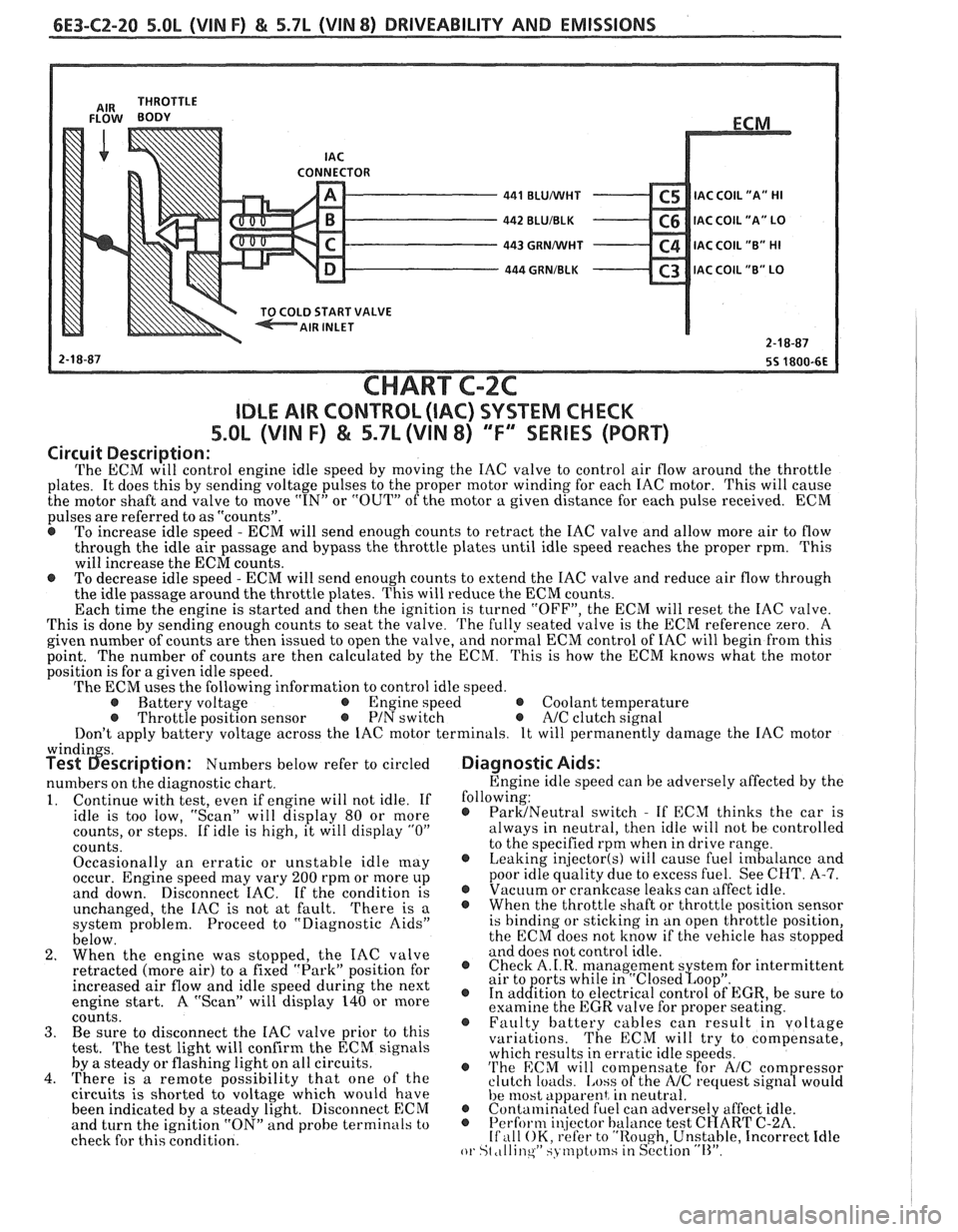
6E3-C2-20 5.0L (VIN F) & 5.7L (WIN 8) DRIVEABILITY AND EMISSIONS
CONNECTOR - 441 BLUMlHT C5 IAC C0lL1'A" HI - 442 BLUIBLK C6 IAC COIL "A" LO - 443 GRNMlHT C4 IAC COIL "B" HI - 444 GRNIBLK C3 lAC COIL "B" LO v
START VALVE
CHART C-2C
IDLE AIR CONTROL (IAC) SYSTEM CHECK
S.OL (VIN F) & 5.7L (VIN 8) "F'" SERIES (PORT)
Circuit Description:
The ECM will control engine idle speed by moving the IAC valve to control air flow around the throttle
plates. It does this by sending voltage pulses to the proper motor winding for each IAC motor. This will cause
the motor shaft and valve to move
"IN" or "OUT" of the motor a given distance for each pulse received. ECM
pulses are referred to as "counts".
@ To increase idle speed - ECM will send enough counts to retract the IAC valve and allow more air to flow
through the idle air passage and bypass the throttle plates until idle speed reaches the proper rpm. This
will increase the ECM counts.
e To decrease idle speed - ECM will send enough counts to extend the IAC valve and reduce air flow through
the idle passage around the throttle plates. This will reduce the ECM counts.
Each time the engine is started and then the ignition is turned "OFF", the ECM will reset the IAC valve.
This is done by sending enough counts to seat the valve.
The fully seated valve is the ECM reference zero. A
given number of counts are then issued to open the valve, and normal ECM control of IAC will begin from this
point. The
number of counts are then calculated by the ECM. This is how the ECM knows what the motor
position is for a given idle speed.
The ECM uses the following information to control idle speed.
@ Battery voltage @ Engine speed @ Coolant temperature @ Throttle position sensor @ PIN switch e A/C clutch signal
Don't apply battery voltage across the IAC motor terminals. It will permanently damage the IAC motor
windin s. Test 6escription: Numbers below refer to circled
numbers on the diagnostic chart.
1. Continue with test, even if engine will not idle. If
idle is too low, "Scan" will display 80 or more
counts, or steps. If idle is high, it will display
"0"
counts.
Occasionally an erratic or unstable idle
[nay occur. Engine speed may vary 200 rpm or more up
and down. Disconnect IAC. If the condition is
unchanged, the IAC is not at fault.
There is a
system problem. Proceed to "Diagnostic Aids"
below.
2. When the engine was stopped, the IAC valve
retracted (more air) to
a fixed "Park" position for
increased air flow and idle speed during the next
engine start. A "Scan" will display 140 or more
coiints. 3. Be sure to disconnect the IAC valve prior to this
test.
The test light will confirm the ECM signals
by a steady or flashing light on all circuits.
4. There is a remote possibility that one of the
circuits is shorted to voltage which would have
been indicated by a steady light. Disconnect ECM
and turn the ignition "ON" and probe terminals to
check for this condition.
Diagnostic Aids:
Engine idle speed can be adversely affected by the
following:
@ ParMNeutral switch - If ECM thinks the car is
always in neutral, then idle will not be controlled
to the specified rpm when in drive range.
@ Leaking injector(s) will cause fuel imbalance and
poor idle quality due to excess fuel. See CHT.
A-7. @ Vacuum or crankcase leaks can affect idle. @ Whenthethrottleshaftorthrottlepositionsensor
is binding or sticking in an open throttle position,
the ECM does not know if the vehicle has stopped
and does not control idle.
@ Check A.I.R. management s stem for intermittent
air to orts while in "~losed~oo~". @ In ad&tion to electrical control of EGR, be sure to
examine the EGR valve for proper seating.
@ Faulty battery cables can result in voltage
variations. The ECM will try to compensate,
which results in erratic idle speeds.
@ 'I'he ECM will com ensate for A/C com ressor
clutch loacls. [.ass ofthe NC request sign8 would
he 11lost apparent, in neutral. @ Contalninatecl fuel can adverse1 affect idle. @ Perform i~!jector balance test C~ART C-2A. If ,111 OK, refer to "Rough, Unstable, Incorrect Idle or St ,tllinqW SJ tnptcfinsiin S~'ction "11''.
Page 920 of 1825
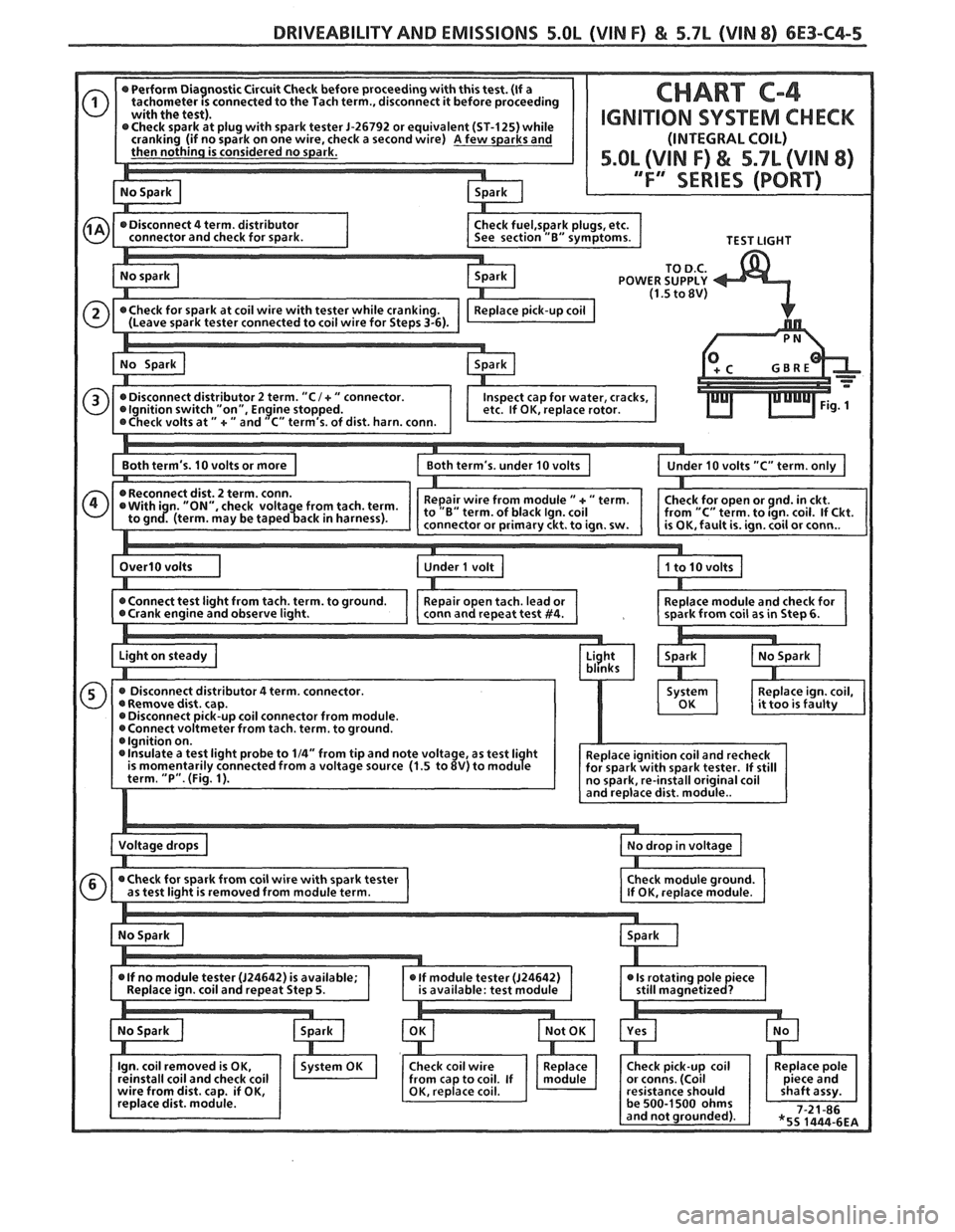
DRIVEABILITY AND EMISSIONS 5.OL (VIN F) & 5.7L (VIN 8) 6E3-C4-5
26792 or equivalent (ST-125) while k a second wire) A few sparks and
CHART C-4
IGNIVION SYSTEM CHECK
(INTEGRAL COIL)
5.OL (VIN F) & 5.7L (VIN 8)
/ .F" SERIES (PORT)
TEST LIGHT
POWER SUPPLY
I
dist. harn. conn.
0
ter from tach, term. to ground.
Page 925 of 1825

6E3-C5-4 5.OL (VIN F) & 5.7L (VIN 8) DRIVEABILITY AND EMISSIONS
CHART C-5
ELECTRONIC SPARK CONTROL
5.OL (VIN F) & 5.7L (VIN 8) ""F-ERIES (PORT)
Circuit Description:
Electronic spark control is accomplished with a module that sends a voltage signal to the ECM. As the
knock sensor detects engine knock, the voltage from the
ESC module to the ECM is shut "OFF" and this signals
the ECM to retard timing, if engine rpm is over about 900.
Test Description: Numbers below refer to circled
numbers on the diagnostic chart.
1.
If a Code 43 is not set, but a knock signal is
indicated while running at 1500 rpm, listen for an
internal engine noise. Under a no load condition,
there should not be any detonation, and if knock is
indicated, an internal engine problem may exist.
2. Usually a knock signal can be generated by
tapping on the right exhaust manifold. This test
can also be performed at idle. Test number
1 was
run at 1500 rpm to determine if a constant knock
signal was present, which would affect engine
performance.
3. This tests whether the knock signal is due to the
sensor,
a basic engine problem, or the ESC
module.
4. If the module ground circuit is faulty, the ESC
module will not function correctly. The test light
should light indicating the ground circuit is
OK.
5. Contacting CKT 496, with a test light to 12 volts,
should generate a knock signal to determine
whether the knock sensor is faulty, or the ESC
module can't recognize a knock signal.
Diagnostic Aids:
"Scan" tools have two positions to diagnose the
ESC system. The knock signal can be tnonitored to see
if the knock sensor is detecting a knock condition and
if the ESC module is functioning, knock signal should
display "YES", whenever detonation is present. The
knock retard position on the "Scan" displays the
amount of spark retard the ECM is commanding. The
ECM can retard the timing up to 'LO degrees.
If the ESC system checks
OK, but detonation is
the complaint, refer to
"Detonation/Spark Knock" in
Section
"B".
Page 926 of 1825
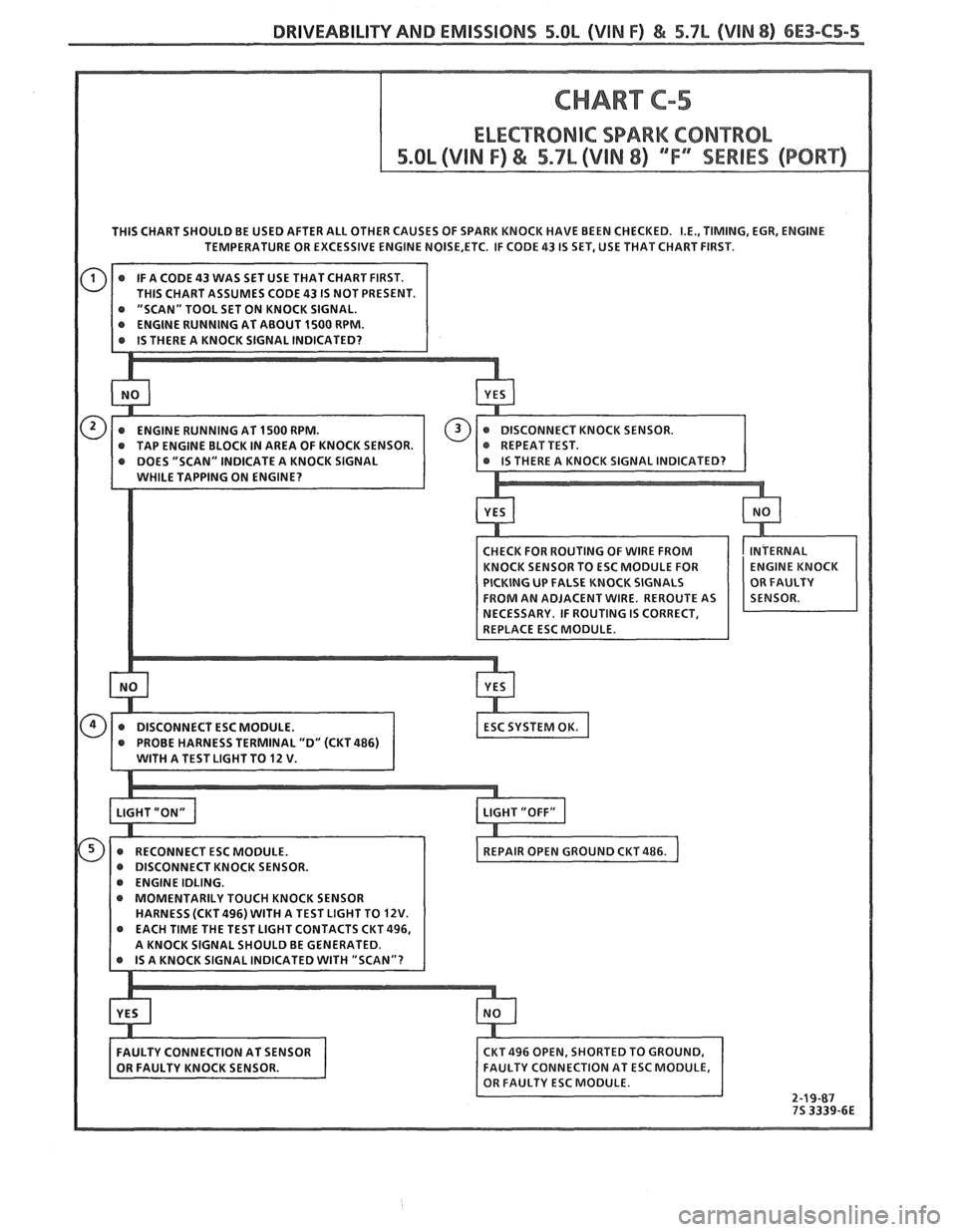
DRIVEABILITY AND EMISSIONS 5.0L (VIN F) & 5.7b (VIN 8) 6E3-C5-5
THIS CHART SHOULD BE USED AFTER ALL OTHER CAUSES OF SPARK KNOCK HAVE BEEN CHECKED. I.E., TIMING, EGR, ENGINE
TEMPERATURE OR EXCESSIVE ENGINE
NOISE,ETC. IF CODE 43 IS SET, USE THAT CHART FIRST.
@ "SCAN" TOOL SET ON KNOCK SIGNAL.
@ RECONNECT ESC MODULE.
DISCONNECT KNOCK SENSOR.
@ ENGINE IDLING.
MOMENTARILY TOUCH KNOCK SENSOR
HARNESS (CKT
496) WITH A TEST LIGHT TO 12V.
Page 933 of 1825
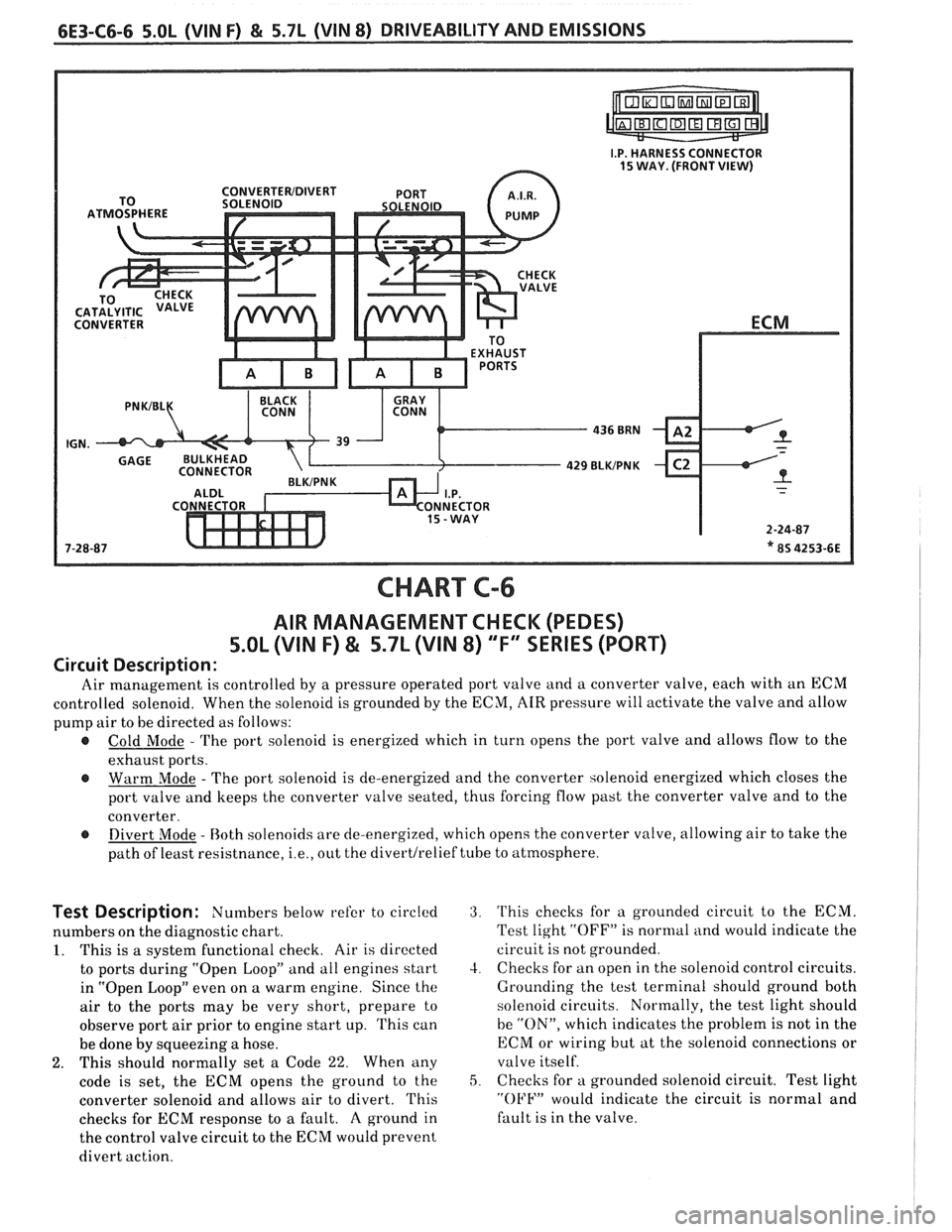
6E3-C6-6 5.OL (VIN F) & 5.7L (VIN 8) DRIVEABILITY AND EMISSIONS
AIR MANAGEMENT CHECK (PEDES)
5.OL (VIN F) & 5.7L (VIN 8) "F" SERIES (PORT)
Circuit Description:
Air management is controlled by a pressure operated port valve and a converter valve, each with an ECM
controlled solenoid. When the solenoid is grounded by the ECM, AIR pressure will activate the valve and allow
pump air to be directed as follows:
@ Cold Mode - The port solenoid is energized which in turn opens the port valve and allows flow to the
exhaust ports.
@ Warm Mode - The port solenoid is de-energized and the converter solenoid energized which closes the
port valve and keeps the converter valve seated, thus forcing flow past the converter valve and to the
converter.
@ Divert Mode - Both solenoids are de-energized, which opens the converter valve, allowing air to take the
path of least resistnance,
i.e., out the di~ertl~elief tube to atmosphere.
Test Description: Numbers below refer to circled
numbers on the diagnostic chart.
1. This is a system functional check. Air is directed
to ports during "Open Loop" and all engines start
in "Open Loop" even on a warm engine. Since the
air to the ports may be very short, prepare to
observe port air prior to engine start up. This can
be done by squeezing a hose.
2. This should normally set a Code 22. When any
code is set, the ECM opens the ground to the
converter solenoid and allows air to divert. This
checks for ECM response to a fault. A ground in
the control valve circuit to the ECM would prevent
divert action.
3. This checks for a grounded circuit to the ECM.
Test light
"OFF" is normal and would indicate the
circuit is not grounded.
4. Checks for an open in the solenoid control circuits.
Grounding the test terminal should ground both
solenoid circuits. Normally, the test light should
be
"ON", which indicates the problem is not in the
ECM or wiring but at the solenoid connections or
valve itself.
5, Checks for a grounded solenoid circuit. Test light
"OFF" would indicate the circuit is normal and
fault is in the valve.